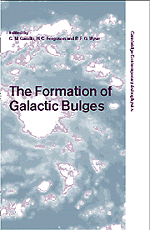Book contents
- Frontmatter
- Contents
- Preface
- Dedication: In Memory of Olin Eggen
- Part 1 Introduction
- Part 2 The Epoch of Bulge Formation
- Origin of Bulges
- Deep sub-mm Surveys: High-z ULIRGs and the Formation of Spheroids
- Ages and Metallicities for Stars in the Galactic Bulge
- Integrated Stellar Populations of Bulges: First Results
- HST-NICMOS Observations of Galactic Bulges: Ages and Dust
- Inside-Out Bulge Formation and the Origin of the Hubble Sequence
- Part 3 The Timescales of Bulge Formation
- Part 4 Physical Processes in Bulge Formation
- Part 5 Bulge Phenomenology
- Part 6 Conference Summary
- Index
Deep sub-mm Surveys: High-z ULIRGs and the Formation of Spheroids
from Part 2 - The Epoch of Bulge Formation
Published online by Cambridge University Press: 10 November 2010
- Frontmatter
- Contents
- Preface
- Dedication: In Memory of Olin Eggen
- Part 1 Introduction
- Part 2 The Epoch of Bulge Formation
- Origin of Bulges
- Deep sub-mm Surveys: High-z ULIRGs and the Formation of Spheroids
- Ages and Metallicities for Stars in the Galactic Bulge
- Integrated Stellar Populations of Bulges: First Results
- HST-NICMOS Observations of Galactic Bulges: Ages and Dust
- Inside-Out Bulge Formation and the Origin of the Hubble Sequence
- Part 3 The Timescales of Bulge Formation
- Part 4 Physical Processes in Bulge Formation
- Part 5 Bulge Phenomenology
- Part 6 Conference Summary
- Index
Summary
Deep surveys of the sky at millimeter wavelengths have revealed a population of ultra-luminous infrared galaxies (ULIRGs) at high redshifts. These appear similar to local objects of similar luminosities (such as Arp220) but are much more ‘important’ at high redshift than at low resdhift, in the sense that they represent a much larger fraction of the total luminous output of the distant Universe than they do locally. In fact the ULIRGs at high redshift are producing a significant fraction (≥ 15%) of the total luminous output of the Universe averaged over all wavelengths and all epochs. The high-z ULIRGs could plausibly be responsible for producing the metal-rich spheroidal components of galaxies, including the bulges of spiral galaxies. In this case we would infer from the redshift distribution of the sources that much of this activity is probably happening relatively recently at z ≤ 2.
Introduction
Despite a great deal of progress in recent years, there still remain major uncertainties in our observational picture of the formation and evolution of galaxies in the high redshift Universe. Not least, the relationship between the star formation activity seen at high redshift and the present-day morphological components of the galaxy population, including the bulges that are the subject of this conference, remains unclear. The origin of the stars in the metal-rich spheroidal components of present-day galaxies, which constitute a half to two-thirds of all stars in the Universe (see Fukugita et al. 1998), is thus an unsolved observational question.
- Type
- Chapter
- Information
- The Formation of Galactic Bulges , pp. 26 - 37Publisher: Cambridge University PressPrint publication year: 2000
- 2
- Cited by



